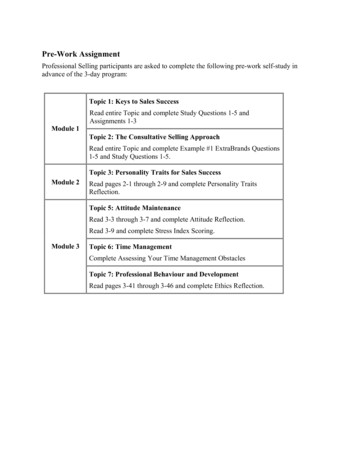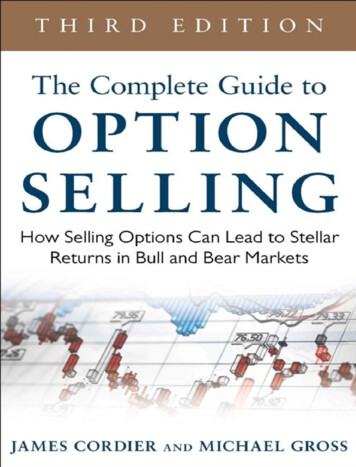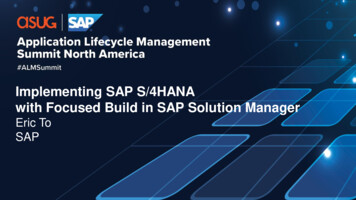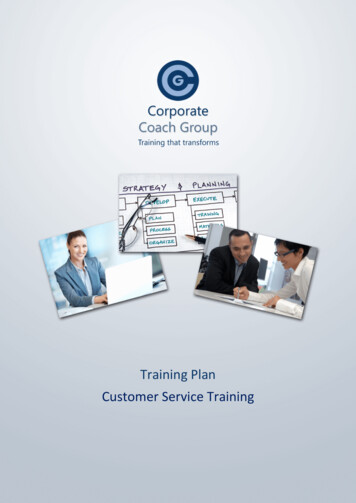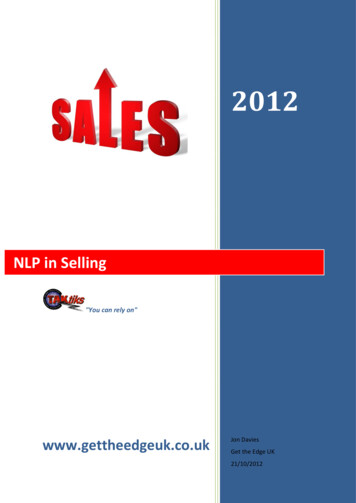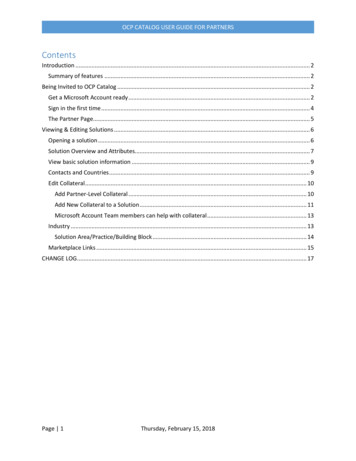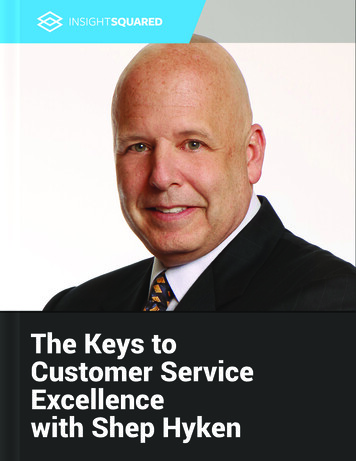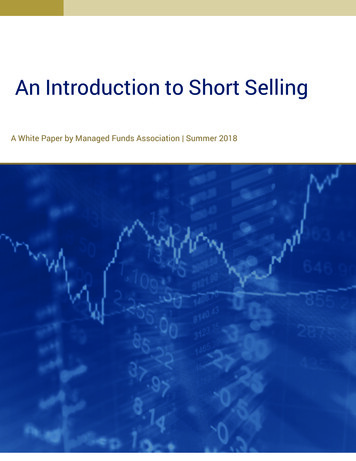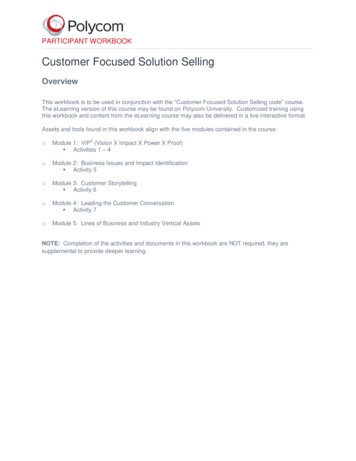
Transcription
PARTICIPANT WORKBOOKCustomer Focused Solution SellingOverviewThis workbook is to be used in conjunction with the “Customer Focused Solution Selling code” course.The eLearning version of this course may be found on Polycom University. Customized training usingthis workbook and content from the eLearning course may also be delivered in a live interactive format.Assets and tools found in this workbook align with the five modules contained in the course:2oModule 1: VIP (Vision X Impact X Power X Proof) Activities 1 – 4oModule 2: Business Issues and Impact Identification Activity 5oModule 3: Customer Storytelling Activity 6oModule 4: Leading the Customer Conversation Activity 7oModule 5: Lines of Business and Industry Vertical AssetsNOTE: Completion of the activities and documents in this workbook are NOT required, they aresupplemental to provide deeper learning.
PARTICIPANT WORKSHEETModule 1: VIP2 (Vision X Impact X Power X Proof)Activity 1: Cycle, Circle, AwarenessThink about a current customer you are working with and respond to the questions. Begin to think aboutwhat that means to you and how that changes how you interact with them.Customer Name:GRC Cycle: Do you understand where yourcustomer is in the GRC Cycle? Where can you getthis information (stakeholders, internet, etc.)?Golden Circle: Are you connecting the “WHY” to theGRC Cycle? Are you looking for bottom lineimprovements, top line growth, workflowimprovements and advancements to the “WHY”?Buyer Awareness: Where is your buyer in thisprocess? Are their impacts that they haven’t thoughtabout? Do they have a solid idea on the solution?Could there be upsell or “value add” opportunities?
PARTICIPANT WORKSHEETActivity 2: CEO ExerciseCEO Questions and Roadmap: If asked by the CEO, can you offer convincing answers? It is likely thatthe IT Director you are talking with have to answer these tough questions. Can you help him/her with theanswers?1. Why do we need this?2. Who is the best alternative? Can we do it ourselves?3. Is it worth the price?4. Is it more important than other issues? Do we need it now?5. Who does it impact?6. Can we trust them?
Activity 3: Deal ReviewsUse the “deal review” template below to grade yourself on your opportunities. The goal is to score a “1” on each area!VIP2 Coaching Navigator for Deal ReviewsVIP2AnswerWhat’s the CurrentBusiness Issue?Sanity TestZero?Is it a CBI or a technical need?Where did we get this info?Why should they buy?What’s the risk to your sale ifthe customer doesn’t connectus to a CBI?What customerchallengesdifferentiate oursolution?Would the customer agree?Have they agreed?What will they buy?What should they buy?Why this?What’s the risk if we aren’tdifferentiated?What’s the Impact?Did the customer agree? Will theybuy (now)? What should they buy?What’s the risk if the customerdoesn’t know the impact?PowerImpactVisionScore: 1 or 0Score: 1 or 0Score: 1 or 0What level of access(Power)?Do they have signoff authority for thisorder size? Can they buy? Whocares?What’s the risk to your order ifthe Power person isn’t alignedwith the vision and impact?ProofScore: 1 or 0Is the Proof plan inwriting?Has the customer agreed? Will theybuy from us? Can they trust us?What’s the risk to your salescycle if the Proof Plan is not inwriting?Score: 1 or 0
Activity 4: Consultative Approach and Challenger Approach QuestionsReview the questions below. Which of those seem the most relevant and help to ask of the customersyou are working with?Consultative TechniqueChallenger TechniqueListen Questions1. To help set the stage for our meeting today and give greater context for our discussion, can yougive me an understanding/overview from a macro perspective on what initiatives are top of mindfor “company X’.2. How would you describe your overall environment at this time?3. How would you describe your overall charter right now?4. What does your desired state look like in a perfect world?5. What are the biggest gaps from current state to desired state from your perspective?6. What current challenges are you facing that bring you to Polycom today?7. What is most important in the solution you select?8. We talked about why you are here today but why now? (Trying to find impact to their business)a. What happens if you do nothing?b. If you were to execute on this project what could this mean to your business?c. If you were to execute on this project what could this mean to YOU?9. Who are other key stakeholders in this project?a. Are there other groups in your organization that are struggling with an issue (HR,Finance, etc.)?10. How do you recommend we get in front of other stakeholders in this project?11. Can you walk us through your internal process for doing business with your company?12. What is the measurement of success for this initiative?13. How important is it for executives to be satisfied with the solution you choose?14. What bottom line improvements are you working towards?15. What areas of your company do you want to grow or improve (top line improvement)?16. What metrics are important to this project?Costsa. What are your travel costs?b. What’s the goal for reduction?
PARTICIPANT WORKSHEETMergers/Acquisitionsc. What happens if this merger is not a success?d. What timeframe is required for integration?Trainingd. What measurable outcome are you trying to achieve?e. What problems are you trying to address?Lead Questions1. Do you face challenges related to ? (Selected to differentiate fromknown competition, or create need in areas the prospect did not articulate, examples such as:connecting with partners or customers who may have different systems? Low bandwidth inremote offices like India or Africa? A large mobile workforce? Etc )2. Based on the challenge , do you also think it’s important to have the abilityto (integrate seamlessly with other equipment? provide high quality imageswith low bandwidth? provide a solution that works on the latest mobile devices with the highestsecurity?3. Does IT get emergency calls and often times, for simple operational set up?4. Are you running lean on resources, both technical and human?5. Do you receive complaints that the systems are not easy to use?6. Are you challenged with a multi-vendor set up?7. Customer X really values our service options. Would that be of interest to you?8. Is future proofing this purchase a concern?9. Do you have any SLAs in this area?10. Do you have a mobile workforce?11. Do you have occasions where you need asynchronous opportunities for your workforce toparticipate in decision making? Or to review information?12. Most IT leaders tell us they are pressured to get more done with fewer resources. Would you saythat is the case for you?13. Do you have a geographically challenged facility map and workforce?14. XYZ corporation was challenged with capturing the knowledge and experiences of their agingworkforce. We were able to provide them a solution that natively integrated with previouslypurchased infrastructure. Would you like to learn more about applications of that solution?15. Are there instances when your workforce needs to work simultaneously on projects or issues thatrequire content or video collaboration?16. Many other role or vertical specific leading questions Linking Questions1. I heard you say . Is that correct?
Module 2: Business Issues and Impact IdentificationActivity 5: Research and DiscoveryUse the table below to learn more about your customer. Complete the cells “Findings” and “Potential Polycom Solution”.BI CategoryDescriptionFindingsInsight or ActionExternalFactorsFactors outside of thecustomer’s control(regulatory, trends,prices, etc.)Reference external factorsearly in customer conversationto demonstrate youunderstand their business andestablish credibility.BusinessInitiativesInitiatives essential togrowth (new products,acquisitions, etc.)Begin thinking of ways thatPolycom solutions can impacttheir business initiatives.FutureForward lookingstatements, futureplans, etc.Position yourself/Polycom for along-term future relationship.FinancialMetricsRatios, prior yearsuccesses, failures,etc.Quantify the value of Polycomsolutions aligned with theirmetricsSignificantTrendsMarket, product, ordivisional trendsShow creativity with givingthem new ideas related totrendsPotential PolycomSolution
PARTICIPANT WORKSHEETBI CategoryDescriptionRevenueTrend past 3 years, %of revenue change byregion or BUFindingsInsight or ActionDownward trends represent aselling opportunity torecover/improve usingPolycom solutions.Upward trends also representa selling opportunity to cutcosts and improve efficiency.Product orService mixChange up or down,newGross MarginTrend past 3 years, %change by region or BUProfitabilityTrend over past 3 yearsAssetsGrowth or shrink duringpast 3 years, significantassets with any change(accounts receivable,inventory, etc.)Asset categories (other thancash) that show a growth trendrepresent a selling opportunitybecause this means cash isavailable for other investmentsGrowth AreasProduct, solution,region, client base, etc.High growth areas representyour strongest sellingopportunities.Potential PolycomSolution
PARTICIPANT WORKSHEETBI CategoryDescriptionOperationalProcesses, reducecosts, improveperformanceRiskManagementMinimize, monitor, andcontrol the probabilityand/or impact ofunfortunate events ormaximize opportunitiesHiddenOpportunitiesPartnerships, growth,products, etc.C-LevelWho are the C-Levelindividuals?BoardMembersWho are the boardmembers? Do theyhave any connectionswith Polycom and/orcompetitors?FindingsInsight or ActionReferences to theirrelationships, contingencies orother factors provide you withdata points for strengtheningyour business case andsupporting the value ofPolycom solutions.Potential PolycomSolution
Module 3: Customer StorytellingActivity 6: Construct Your StoryName of customer:Describe their business issues? What “integrate collaboration into the workflow” problem were they tryingto solve?What was the solution? Try and use generic terms like “video enabled”, “video capture”, etc.:What were the results/metrics can you share that shows how the problem was solved?Was there a value-add of top-line improvement? If so, what was it?Was there a value-add of bottom-line improvement? If so, what was it?Using the above list, construct your story! Challenge yourself and try to use no more than 5 sentences!Write your story here.Example: “A Federal Credit Union in the mid-West had 50 loan officers serving 120 regional banks. They were losingcustomers because the loan officers couldn’t be in all places at all times. After video enabling all regional facilities,and bull penning the loan officers: a) they are gaining more customers top line growth, and b) they reduced thenumber of loan officers from 50 to 10 bottom line improvement!”Grade your story:CharacteristicWill a similar customer connect (care) about this story? Is it compelling? Will an audience beable to feel any emotion that may induce urgency for them to change?Is the story more about a customer and less about Polycom?Does the story have a “journey” where Polycom solutions helped the customer overcomechallenges?Does it include value-add business issues that the customer was facing?Does it tell HOW Polycom collaboration solutions were integrated into the workflow?Does it include impact (metrics) that Polycom solutions had on the customer business issue?TotalPointvalue105510101050Yourscore
PARTICIPANT WORKSHEETModule 4: Leading the Customer ConversationActivity 7: Construct a Plan for the ConversationScenario: You are meeting with the Director of IT at a company or organization (you can choose thetype of organization from this list). Government Retail & Wholesale Education Oil, Gas, & Energy Healthcare Hospitality Manufacturing Pharmaceutical Financial Services Business Services EntertainmentAssumptions: You are already into the conversation (no need for introductions) IT has told you that they just rolled out Microsoft Lync IT has told you they have some Cisco infrastructure and a mix of Cisco and Polycom endpoints The customer employees are geographically disperse The customer works with others outside of their organization You don’t know much about their workflow integration or utilization You can make up some things ”I read from your annual report ” or “In our phone conversation,you said ”Your Task: Plan your conversation Use resources to help you with your plan Use the “Leading the Customer Conversation Attributes” Use customer stories, listen and link questions, etc. Use the research and discover items and answers you wrote for VIP2 Your plan/questions should help you set the agenda Your plan/questions should help you drive the conversation
PARTICIPANT WORKSHEETModule 5: Lines of Business and Vertical AssetsLine of Business and Verticals Use LOB and Vertical Cards, brainstorm solutions and then list the challenges they solveCustomer Stories on Polycom Web Sites On Polycom.com at htmlOn SalesConnect/PartnerConnect ome/customers/customers/customer-storyassets.html
PARTICIPANT WORKSHEETAppendix – VIP2 DefinitionsVision Current Business Issues (CBI): These are the issues the customer’s company is facing at the highest leveland typically have the attention of the C staff. Examples could include Merger/Acquisition Integration, lack ofcompetitive differentiation, cost management difficulties, global expansion, and many others. Polycom cancontribute to the resolution of some business issues, but not necessarily all. It’s important to uncover theircurrent business issues to either attach yourself as a possible solution or recognize they may have otherpriorities and understand how your purchase may be delayed as a result.Challenges: These are the underlying customer people/process/technology problems that are impeding theCBI. Examples could include low bandwidth in certain parts of the organization, investments in legacyequipment or software, outside stakeholders like customers or vendors with other solutions, longdevelopment cycles, delays in communication based processes, and other challenges. Identifying andconfirming these challenges becomes the foundation for you to establish your credibility as a trusted advisorand establish the need for Polycom capabilities that are differentiators.Impact These are the tangible/measurable and intangible/not measurable outcomes of either implementing aPolycom solution or not implementing a solution. For example, although T&E savings are common, there areother metrics associated with Challenges and CBI’s that are valuable for your customers: these includetangible metrics such as time to successful M/A integration, new business logo acquisition, and ability to“visit” more remote offices in a single day, among others. Intangible results could include career visibility,more time with the family, morale improvement and so on. It’s important to ask your customer’s to identifytheir win if they implement a solution to the Challenges or their loss if they don’t take action so that you canhelp them prioritize their purchase more effectively or avoid a no decision outcome.Power This is the identification and access of the key stakeholders that are required to secure a purchase and thestakeholders that can help you accelerate your sale. Although we rely on IT for many transactions, there aremany business unit stakeholders who have an interest in the CBIs/Challenges/Impact and could help youimprove the prioritization or justification of the sale. Consider the General Manager who has to fly twice amonth to another continent and feels disconnected from her family as an example, or the new CFO who istrying to make his mark by significantly reducing costs or accelerating merger consolidation. When thesestakeholders see a win for themselves or their organization they can be recruited to support your initiative.Proof This is the series of activities the customer will need to experience in order to validate our credibility andtrustworthiness. Common examples are reference checks, proof of concept trials, subject matter expertpresentations and more. It’s important to document the plan activities with the customer in order to moreeffectively manage schedule delays and expectations for the customer and Polycom. Keep in mind, activitieslike POC’s are not always required, and many times are just a thoughtless, uncreative approach to validatingProof. If you’ve developed credibility by doing a great job in building the business rationale for the purchase,you may be in a position to guide the prospect through a more efficient proof step as an alternative tolengthy and costly POC’s.
Customer Focused Solution Selling Overview This workbook is to be used in conjunction with the “Customer Focused Solution Selling code” course. The eLearning version of this course may be found on Polycom University. Customized training using this workbook and content from the eLearning c
